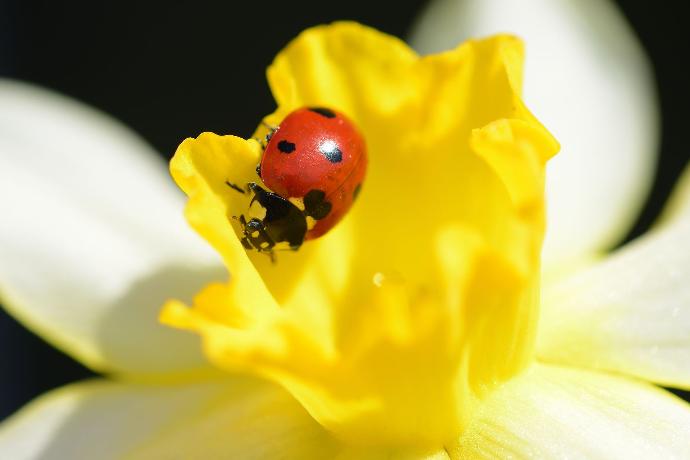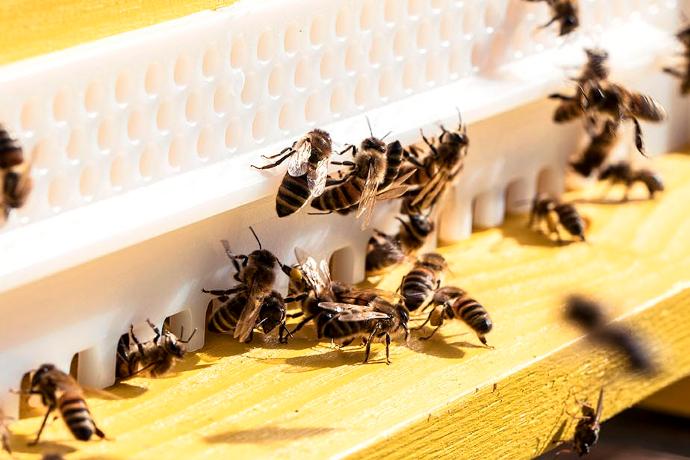Le jardinage, ce n'est pas seulement cultiver des légumes ; c'est aussi l'occasion de découvrir les incroyables insectes du jardin avec vos enfants. Bien qu’on ne les repère pas au premier regard, nos jardins grouillent de vie. Découvrons ensemble les insectes les plus communs, où nous pouvons les trouver et quels sont leurs super pouvoirs!
Les insectes courants dans le jardin
Les coccinelles
Les coccinelles, avec leur couleur rouge vif et leurs tâches noires, sont comme de petits héros pour vos plantes. Vous les trouverez souvent sous les feuilles, là où les pucerons aiment se cacher. Cherchez-les le matin, quand elles sont le plus actives. Voici un fait amusant à partager avec vos enfants : Une coccinelle peut dévorer des centaines de pucerons en une journée, comme un petit aspirateur !

Coccinelle à 7 points (Coccinella septempunctata)
Les papillons
Les papillons amènent du mouvement et de la couleur dans votre jardin. Ils aident les fleurs à pousser en transportant de minuscules grains, appelés pollen, de fleur en fleur. Vous pouvez les voir voltiger dans votre jardin l'après-midi, surtout les jours ensoleillés. Fait amusant : Les papillons goûtent les choses avec leurs pieds !
Papillon Citron (Gonepteryx rhamni)
Les abeilles
Les abeilles font partie des insectes les plus importants au potager. Grâce à elles, les fleurs se transforment en délicieux légumes et fruits. Vous verrez des abeilles bourdonner autour de fleurs colorées le matin et en début d'après-midi. Fait amusant : Les abeilles voient des motifs invisibles pour nous sur les fleurs !

Abeille européenne (Apis mellifera)
Les fourmis
Les fourmis sont peut-être petites, mais elles sont super fortes. Elles aident les plantes en mangeant les débris dans la terre. Vous trouverez souvent des autoroutes de fourmis près des plantes et des rochers. Les fourmis sont actives toute la journée, vous pouvez donc les repérer à n'importe quel moment. Fait amusant : Les fourmis peuvent porter des choses bien plus lourdes qu'elles, comme de petits super-héros !
Fourmi noire des jardins (Lasius niger)
Découvrir ces insectes avec les enfants
Voici quelques activités amusantes à faire avec vos enfants :
- Créez un foyer douillet pour les coccinelles dans votre jardin en utilisant des bâtons et des feuilles.
- Plantez de belles fleurs que les papillons adorent visiter et observez-les voltiger autour de votre jardin l'après-midi.
- Observez les fourmis travailler ensemble pour collecter de la nourriture pour leur foyer à n'importe quel moment de la journée.
- Tenez un journal sur tous les insectes que vous découvrez dans le potager et essayez de les identifier.
Gärtnern bedeutet nicht nur das Anbauen von Gemüse; es ist auch eine Gelegenheit, die erstaunlichen Garteninsekten mit euren Kindern zu erkunden. Auch wenn es auf den ersten Blick nicht danach scheint, sind unsere Gärten voller Leben. Entdecken wir gemeinsam die häufigsten Insekten, wo man sie findet und welche Superkräfte sie haben!
Die häufigsten Insekten im Garten
Marienkäfer
Marienkäfer, mit ihrer leuchtend roten Farbe und den schwarzen Punkten, sind wie kleine Helden für eure Pflanzen. Ihr findet sie oft unter Blättern, wo sich Blattläuse verstecken. Sucht nach ihnen am Morgen, wenn sie am aktivsten sind. Interessanter Fakt, den Ihr mit euren Kindern teilen könnt: Ein Marienkäfer kann an einem Tag hunderte von Blattläusen verschlingen, wie ein kleiner Staubsauger!
Siebenpunkt-Marienkäfer (Coccinella septempunctata)
Schmetterlinge
Schmetterlinge bringen Bewegung und Farbe in euren Garten. Sie helfen den Blumen beim Wachsen, indem sie winzige Körner namens Pollen von einer Blume zur anderen tragen. Ihr könnt sie am Nachmittag herumflattern sehen, besonders an sonnigen Tagen. Interessanter Fakt: Schmetterlinge schmecken mit ihren Füssen!
Zitronenfalter (Gonepteryx rhamni)
Bienen
Bienen gehören zu den wichtigsten Insekten im Garten. Dank ihnen werden Blumen zu köstlichem Gemüse und Obst. Ihr sieht Bienen am Morgen und am frühen Nachmittag um bunte Blumen herumsummen. Interessanter Fakt: Bienen sehen Muster auf Blumen, die für uns unsichtbar sind!

Westliche Honigbiene (Apis mellifera)
Ameisen
Ameisen sind vielleicht klein, aber sie sind super stark. Sie helfen den Pflanzen, indem sie Pflanzenreste im Boden essen. Ihr findet oft Ameisenautobahnen in der Nähe von Pflanzen und Steinen. Ameisen sind den ganzen Tag aktiv, sodass Ihr sie zu jeder Zeit beobachten könnt. Interessanter Fakt: Ameisen können Dinge tragen, die viel schwerer sind als sie selbst, wie kleine Superhelden!
Schwarze Wegameise (Lasius niger)
Diese Insekten mit Kindern erforschen
Hier sind einige lustige Aktivitäten, die Ihr mit euren Kindern unternehmen könnt:
- Erstellt ein gemütliches Zuhause für Marienkäfer in eurem Garten mit Stielen und Blättern.
- Pflanzt wunderschöne Blumen, die Schmetterlinge anziehen, und beobachtet sie am Nachmittag in eurem Garten flattern.
- Beobachtet Ameisen, die den ganzen Tag zusammenarbeiten, um Nahrung für ihr Zuhause zu sammeln.
- Führt ein Tagebuch über alle Insekten, die Ihr im Gemüsegarten entdeckt, und versucht sie zu identifizieren.
Gardening is more than just growing vegetables; it's also an opportunity to explore the incredible garden insects with your children. While they may not be immediately visible, our gardens are teeming with life. Let's together discover the most common insects, where to find them, and what their superpowers are!
Common Insects in the Garden
Ladybugs
Ladybugs, with their bright red color and black spots, are like little heroes for your plants. You'll often find them under leaves, where aphids like to hide. Look for them in the morning when they are most active. Here's a fun fact to share with your children: A ladybug can devour hundreds of aphids in a day, like a little vacuum cleaner!
Seven-spotted ladybug (Coccinella septempunctata)
Butterflies
Butterflies bring movement and color to your garden. They help flowers grow by carrying tiny grains called pollen from one flower to another. You can see them fluttering around your garden in the afternoon, especially on sunny days. Fun fact: Butterflies taste things with their feet!
Common brimstone (Gonepteryx rhamni)
Bees
Bees are among the most important insects in the garden. Thanks to them, flowers turn into delicious vegetables and fruits. You'll see bees buzzing around colorful flowers in the morning and early afternoon. Fun fact: Bees see patterns invisible to us on flowers!

Western honey bee (Apis mellifera)
Ants
Ants may be small, but they are super strong. They help plants by eating debris in the soil. You'll often find ant highways near plants and rocks. Ants are active all day, so you can spot them at any time. Fun fact: Ants can carry things much heavier than themselves, like little superheroes!
Black garden ant (Lasius niger)
Exploring These Insects with Children
Here are some fun activities to do with your children:
- Create a cozy home for ladybugs in your garden using sticks and leaves.
- Plant beautiful flowers that butterflies love to visit and watch them flutter around
- your garden in the afternoon.
- Observe ants working together to collect food for their home at any time of the day.
- Keep a journal of all the insects you discover in the vegetable garden and try to identify them.
La coltivazione dell'orto non significa solo far crescere verdure; è anche un'opportunità per esplorare gli incredibili insetti dell'orto con i tuoi bambini. Anche se potrebbero non essere immediatamente visibili, i nostri orti sono pieni di vita. Scopriamo insieme gli insetti più comuni, dove trovarli e quali sono i loro superpoteri!
Insetti Comuni nell'Orto
Coccinelle
Le coccinelle, con il loro colore rosso brillante e i punti neri, sono come piccoli eroi per le tue piante. Spesso le troverai sotto le foglie, dove gli afidi si nascondono. Cercale al mattino quando sono più attive. Ecco un fatto divertente da condividere con i tuoi bambini: una coccinella può divorare centinaia di afidi in un giorno, come un piccolo aspirapolvere!
Coccinella comune (Coccinella septempunctata)
Farfalle
Le farfalle portano movimento e colore nel tuo giardino. Aiutano i fiori a crescere trasportando piccoli granelli chiamati polline da un fiore all'altro. Puoi vederle volteggiare nel tuo giardino nel pomeriggio, specialmente nelle giornate soleggiate. Fatto divertente: le farfalle assaggiano le cose con i loro piedi!

Cedronella (Gonepteryx rhamni)
Ape
Le api sono tra gli insetti più importanti nell'orto. Grazie a loro, i fiori si trasformano in deliziosi ortaggi e frutta. Vedrai le api ronzare intorno ai fiori colorati al mattino e all'inizio del pomeriggio. Fatto divertente: le api vedono schemi invisibili per noi sui fiori!

Ape europea (Apis mellifera)
Formiche
Le formiche potrebbero essere piccole, ma sono super forti. Aiutano le piante mangiando detriti nel terreno. Spesso troverai autostrade di formiche vicino alle piante e alle rocce. Le formiche sono attive tutto il giorno, quindi puoi vederle in qualsiasi momento. Fatto divertente: le formiche possono trasportare cose molto più pesanti di loro, come piccoli supereroi!

Formica nera dei giardini (Lasius niger)
Esplorare questi insetti con i bambini
Ecco alcune divertenti attività da fare con i tuoi bambini:
- Crea un'accogliente casa per le coccinelle nel tuo giardino usando bastoncini e foglie.
- Pianta bellissimi fiori che le farfalle amano visitare e osservale volteggiare nel tuo giardino nel pomeriggio.
- Osserva le formiche che lavorano insieme per raccogliere il cibo per la loro casa in qualsiasi momento della giornata.
- Tieni un diario di tutti gli insetti che scopri nell'orto e cerca di identificarli.




Découvrez le monde des insectes au potager avec vos enfants